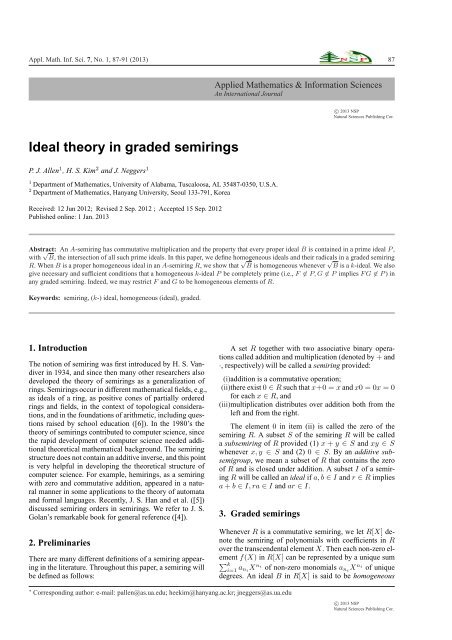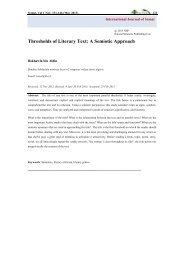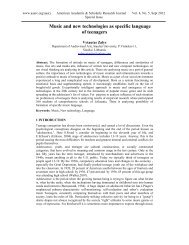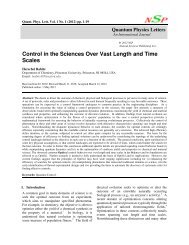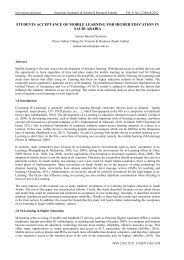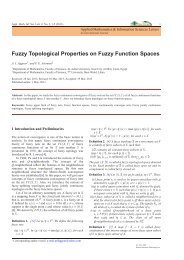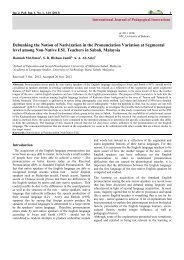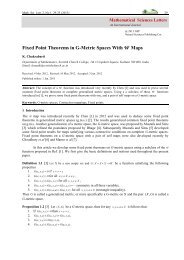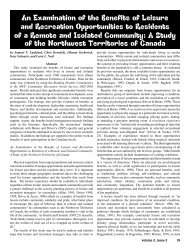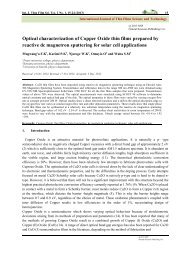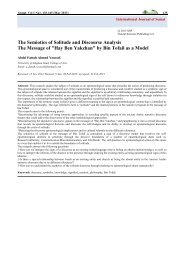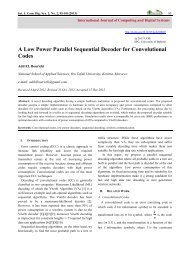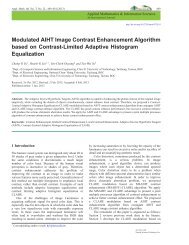Ideal theory in graded semirings - Natural Sciences Publishing
Ideal theory in graded semirings - Natural Sciences Publishing
Ideal theory in graded semirings - Natural Sciences Publishing
You also want an ePaper? Increase the reach of your titles
YUMPU automatically turns print PDFs into web optimized ePapers that Google loves.
Appl. Math. Inf. Sci. 7, No. 1, 87-91 (2013) 87<br />
Applied Mathematics & Information <strong>Sciences</strong><br />
An International Journal<br />
c○ 2013 NSP<br />
<strong>Natural</strong> <strong>Sciences</strong> Publish<strong>in</strong>g Cor.<br />
<strong>Ideal</strong> <strong>theory</strong> <strong>in</strong> <strong>graded</strong> semir<strong>in</strong>gs<br />
P. J. Allen 1 , H. S. Kim 2 and J. Neggers 1<br />
1 Department of Mathematics, University of Alabama, Tuscaloosa, AL 35487-0350, U.S.A.<br />
2 Department of Mathematics, Hanyang University, Seoul 133-791, Korea<br />
Received: 12 Jun 2012; Revised 2 Sep. 2012 ; Accepted 15 Sep. 2012<br />
Published onl<strong>in</strong>e: 1 Jan. 2013<br />
Abstract: An A-semir<strong>in</strong>g has commutative multiplication and the property that every proper ideal B is conta<strong>in</strong>ed <strong>in</strong> a prime ideal P ,<br />
with √ B, the <strong>in</strong>tersection of all such prime ideals. In this paper, we def<strong>in</strong>e homogeneous ideals and their radicals <strong>in</strong> a <strong>graded</strong> semir<strong>in</strong>g<br />
R. When B is a proper homogeneous ideal <strong>in</strong> an A-semir<strong>in</strong>g R, we show that √ B is homogeneous whenever √ B is a k-ideal. We also<br />
give necessary and sufficient conditions that a homogeneous k-ideal P be completely prime (i.e., F ∉ P, G ∉ P implies F G ∉ P ) <strong>in</strong><br />
any <strong>graded</strong> semir<strong>in</strong>g. Indeed, we may restrict F and G to be homogeneous elements of R.<br />
Keywords: semir<strong>in</strong>g, (k-) ideal, homogeneous (ideal), <strong>graded</strong>.<br />
1. Introduction<br />
The notion of semir<strong>in</strong>g was first <strong>in</strong>troduced by H. S. Vandiver<br />
<strong>in</strong> 1934, and s<strong>in</strong>ce then many other researchers also<br />
developed the <strong>theory</strong> of semir<strong>in</strong>gs as a generalization of<br />
r<strong>in</strong>gs. Semir<strong>in</strong>gs occur <strong>in</strong> different mathematical fields, e.g.,<br />
as ideals of a r<strong>in</strong>g, as positive cones of partially ordered<br />
r<strong>in</strong>gs and fields, <strong>in</strong> the context of topological considerations,<br />
and <strong>in</strong> the foundations of arithmetic, <strong>in</strong>clud<strong>in</strong>g questions<br />
raised by school education ([6]). In the 1980’s the<br />
<strong>theory</strong> of semir<strong>in</strong>gs contributed to computer science, s<strong>in</strong>ce<br />
the rapid development of computer science needed additional<br />
theoretical mathematical background. The semir<strong>in</strong>g<br />
structure does not conta<strong>in</strong> an additive <strong>in</strong>verse, and this po<strong>in</strong>t<br />
is very helpful <strong>in</strong> develop<strong>in</strong>g the theoretical structure of<br />
computer science. For example, hemir<strong>in</strong>gs, as a semir<strong>in</strong>g<br />
with zero and commutative addition, appeared <strong>in</strong> a natural<br />
manner <strong>in</strong> some applications to the <strong>theory</strong> of automata<br />
and formal languages. Recently, J. S. Han and et al. ([5])<br />
discussed semir<strong>in</strong>g orders <strong>in</strong> semir<strong>in</strong>gs. We refer to J. S.<br />
Golan’s remarkable book for general reference ([4]).<br />
2. Prelim<strong>in</strong>aries<br />
There are many different def<strong>in</strong>itions of a semir<strong>in</strong>g appear<strong>in</strong>g<br />
<strong>in</strong> the literature. Throughout this paper, a semir<strong>in</strong>g will<br />
be def<strong>in</strong>ed as follows:<br />
A set R together with two associative b<strong>in</strong>ary operations<br />
called addition and multiplication (denoted by + and<br />
·, respectively) will be called a semir<strong>in</strong>g provided:<br />
(i)addition is a commutative operation;<br />
(ii)there exist 0 ∈ R such that x+0 = x and x0 = 0x = 0<br />
for each x ∈ R, and<br />
(iii)multiplication distributes over addition both from the<br />
left and from the right.<br />
The element 0 <strong>in</strong> item (ii) is called the zero of the<br />
semir<strong>in</strong>g R. A subset S of the semir<strong>in</strong>g R will be called<br />
a subsemir<strong>in</strong>g of R provided (1) x + y ∈ S and xy ∈ S<br />
whenever x, y ∈ S and (2) 0 ∈ S. By an additive subsemigroup,<br />
we mean a subset of R that conta<strong>in</strong>s the zero<br />
of R and is closed under addition. A subset I of a semir<strong>in</strong>g<br />
R will be called an ideal if a, b ∈ I and r ∈ R implies<br />
a + b ∈ I, ra ∈ I and ar ∈ I.<br />
3. Graded semir<strong>in</strong>gs<br />
Whenever R is a commutative semir<strong>in</strong>g, we let R[X] denote<br />
the semir<strong>in</strong>g of polynomials with coefficients <strong>in</strong> R<br />
over the transcendental element X. Then each non-zero element<br />
f(X) <strong>in</strong> R[X] can be represented by a unique sum<br />
∑ k<br />
i=1 a n i<br />
X n i<br />
of non-zero monomials a ni X n i<br />
of unique<br />
degrees. An ideal B <strong>in</strong> R[X] is said to be homogeneous<br />
∗ Correspond<strong>in</strong>g author: e-mail: pallen@as.ua.edu; heekim@hanyang.ac.kr; jneggers@as.ua.edu<br />
c○ 2013 NSP<br />
<strong>Natural</strong> <strong>Sciences</strong> Publish<strong>in</strong>g Cor.
88 P. J. Allen et. al. : <strong>Ideal</strong> <strong>theory</strong> <strong>in</strong> <strong>graded</strong> ...<br />
if f(X) = ∑ k<br />
i=1 a n i<br />
X n i<br />
∈ B implies a ni X n i<br />
∈ B, for<br />
each i. In this article, a number of properties of homogeneous<br />
ideals will be derived. However, it will not be necessary<br />
to restrict ourselves to polynomial semir<strong>in</strong>gs s<strong>in</strong>ce<br />
homogeneous ideals can be studied <strong>in</strong> semir<strong>in</strong>gs more general<br />
than polynomial semir<strong>in</strong>gs, namely <strong>in</strong> <strong>graded</strong> semir<strong>in</strong>gs.<br />
The first problem encounted will be the presentation<br />
of a def<strong>in</strong>ition of a <strong>graded</strong> semir<strong>in</strong>g.<br />
Def<strong>in</strong>ition 3.1. Let {R q } q∈Z be a collection of additive<br />
subsemigroups of a semir<strong>in</strong>g R. We say that R is the<br />
<strong>in</strong>ternal direct sum of the collection {R q } q∈Z provided:<br />
(1)Each non-zero element x <strong>in</strong> R has a unique representation<br />
of the form ∑ k<br />
i=1 r q i<br />
where q i ≠ q j if i ≠ j and<br />
r qi is a non-zero element <strong>in</strong> R qi for each i; and<br />
(2)If r q1 , r q2 , · · · , r qk are non-zero elements <strong>in</strong> R where<br />
q i ≠ q j if i ≠ j, and each r qi ∈ R qi , then ∑ k<br />
i=1 r q i<br />
is<br />
a non-zero element <strong>in</strong> R.<br />
The notation “R = ∑ q∈Z R q ” will be used to <strong>in</strong>dicate<br />
that the semir<strong>in</strong>g R is the <strong>in</strong>ternal direct sum of the<br />
collection {R q } q∈Z . Although the collection {R q } q∈Z <strong>in</strong><br />
the above def<strong>in</strong>ition could be taken with Z any non-empty<br />
set, we will always use Z to denote the r<strong>in</strong>g of <strong>in</strong>tegers.<br />
Let Z be denote the r<strong>in</strong>g of <strong>in</strong>tegers and let {R q } q∈Z<br />
be a collection of additive subsemigroups of a semir<strong>in</strong>g<br />
R. The symbol ∑ q∈Z R q will denote the set consist<strong>in</strong>g of<br />
0 together with all x <strong>in</strong> R for which there exist <strong>in</strong>tegers<br />
q 1 , q 2 , · · · , q k , (q i ≠ q j if i ≠ j), and non-zero elements<br />
r q1 , r q2 , · · · , r qk such that r qi<br />
Def<strong>in</strong>ition 3.2. A semir<strong>in</strong>g R is said to be <strong>graded</strong> if<br />
there exists a collection {R q } q∈Z of additive subsemigroups<br />
of R satisfy<strong>in</strong>g the follow<strong>in</strong>g conditions:<br />
∈ R qi and x = ∑ k<br />
i=1 r q i<br />
.<br />
(1)R = ∑ q∈Z R q;<br />
(2)R q R q ′ ⊂ R q+q ′ for each q, q ′ ∈ Z;<br />
(3)If r q1 , r q2 , · · · , r qk are non-zero elements <strong>in</strong> R where<br />
q i ≠ q j if i ≠ j, and each r qi ∈ R qi , then ∑ k<br />
i=1 r q i<br />
is<br />
a non-zero element <strong>in</strong> R.<br />
∑ Whenever R is a <strong>graded</strong> semir<strong>in</strong>g, the notation “R =<br />
q∈Z R q” will be used to <strong>in</strong>dicate that {R q } q∈Z is the<br />
given collection of additive subsemigroups satisfy<strong>in</strong>g the<br />
above def<strong>in</strong>ition.<br />
Theorem 3.3. If R = ∑ q∈Z R q is a <strong>graded</strong> semir<strong>in</strong>g,<br />
and if n and m are dist<strong>in</strong>ct <strong>in</strong>tegers, then R n ∩ R m = ∅ or<br />
R n ∩ R m = {0}, where 0 denotes the zero <strong>in</strong> R.<br />
Proof. Assume there exists a non-zero element x <strong>in</strong> R<br />
such that x ∈ R n ∩ R m . Thus, x ∈ R n and x ∈ R m and it<br />
follows that x does not have a unique representation of the<br />
form ∑ k<br />
i=1 r q i<br />
. Consequently, R is not the <strong>in</strong>ternal direct<br />
sum of the collection {R q } q∈Z , a contradiction. Note that<br />
it may happen that R n ∩ R m = ∅. ⊓⊔<br />
Def<strong>in</strong>ition 3.4. Let R = ∑ q∈Z R q be a <strong>graded</strong> semir<strong>in</strong>g.<br />
An element of R is said to be homogeneous if it belongs<br />
to an R q , and it is said to be homogeneous of degree<br />
q if it belongs to R q and is different from zero.<br />
S<strong>in</strong>ce the <strong>graded</strong> semir<strong>in</strong>g R is the <strong>in</strong>ternal direct sum<br />
of the collection {R q } q∈Z , it is clear that every non-zero<br />
element x <strong>in</strong> R can be written, <strong>in</strong> a unique way, as a f<strong>in</strong>ite<br />
sum of non-zero homogeneous elements of dist<strong>in</strong>ct<br />
degrees.<br />
Def<strong>in</strong>ition 3.5. Let R = ∑ q∈Z R q be a <strong>graded</strong> semir<strong>in</strong>g<br />
and let x be a non-zero element <strong>in</strong> R. If ∑ k<br />
i=1 r q i<br />
is the<br />
decomposition of x <strong>in</strong>to non-zero homogeneous elements<br />
of dist<strong>in</strong>ct degree, the homogeneous elements r q1 , r q2 , · · · , r qk<br />
will be called the homogeneous components of x, and the<br />
homogeneous component of x of least degree will be called<br />
the <strong>in</strong>itial component of x.<br />
Let R be a semir<strong>in</strong>g and let R[X] be the semir<strong>in</strong>g of<br />
polynomials over R. If q is a non-negative <strong>in</strong>teger, then<br />
R q will denote the set consist<strong>in</strong>g of the zero polynomial<br />
O(X) together with all basic polynomials of degree q. If<br />
q is a negative <strong>in</strong>teger, R q will denote the set {O(X)}. It<br />
is clear that {R q } q∈Z is a collection of additive subsemigroups<br />
of the semir<strong>in</strong>g R[X]. With the aid of this notation,<br />
it can be shown that every polynomial semir<strong>in</strong>g is a <strong>graded</strong><br />
semir<strong>in</strong>g.<br />
Theorem 3.6. If R is a semir<strong>in</strong>g , then R[X] = ∑ q∈Z R q<br />
is a <strong>graded</strong> semir<strong>in</strong>g, where the collection {R q } q∈Z is def<strong>in</strong>ed<br />
as above.<br />
Proof. It is easy to observe that R[X] is the <strong>in</strong>ternal<br />
direct sum of the collection {R q } q∈Z . If a q X q and b q ′X q′<br />
are basic polynomials of degree q and q ′ , respectively, then<br />
a q X q · b q ′X q′ is either O(X) or a basic polynomial of<br />
degree q+q ′ . Thus, R q R q ′ ⊂ R q+q ′ for each q, q ′ ∈ Z. An<br />
<strong>in</strong>spection of the def<strong>in</strong>ition of addition <strong>in</strong> R[X] shows that<br />
condition (3) <strong>in</strong> Def<strong>in</strong>ition 3.2 is satisfied, and the proof is<br />
complete. ⊓⊔<br />
The follow<strong>in</strong>g example will show that there exist <strong>graded</strong><br />
semir<strong>in</strong>gs other than polynomial semir<strong>in</strong>gs, and it will be<br />
clear that the notion of a <strong>graded</strong> semir<strong>in</strong>g is a generalization<br />
of the notion of a polynomial semir<strong>in</strong>g.<br />
Example 3.7. Let R be a semir<strong>in</strong>g. Let R 0 = R and let<br />
R q = {0} if q is a non-zero element <strong>in</strong> Z. It is clear that<br />
{R q } q∈Z is a collection of additive subsemigroups of the<br />
semir<strong>in</strong>g R. An <strong>in</strong>spection shows that R = ∑ q∈Z R q is a<br />
<strong>graded</strong> semir<strong>in</strong>g. If R has only a f<strong>in</strong>ite number of elements,<br />
then the f<strong>in</strong>ite, <strong>graded</strong> semir<strong>in</strong>g R = ∑ q∈Z R q cannot be a<br />
polynomial semir<strong>in</strong>g, s<strong>in</strong>ce polynomial semir<strong>in</strong>gs conta<strong>in</strong><br />
an <strong>in</strong>f<strong>in</strong>ite number of elements.<br />
4. Homogeneous ideals <strong>in</strong> <strong>graded</strong> semir<strong>in</strong>gs<br />
n=0<br />
Def<strong>in</strong>ition 4.1. Let B be an ideal <strong>in</strong> the <strong>graded</strong> semir<strong>in</strong>g<br />
R = ∑ q∈Z R q. If the homogeneous components of each<br />
non-zero element <strong>in</strong> B belong to B, then B will be called<br />
a homogeneous ideal.<br />
Theorem 4.2. If B is an ideal <strong>in</strong> the commutative semir<strong>in</strong>g<br />
R, then B[X] is a homogeneous ideal <strong>in</strong> the <strong>graded</strong><br />
semir<strong>in</strong>g R[X] = ∑ q∈Z R q.<br />
∞∑<br />
Proof. Let f(X) = a n X n be a non-zero polynomial<br />
<strong>in</strong> B[X] and let ∑ k<br />
i=1 a q i<br />
X q i<br />
be the decomposition<br />
c○ 2013 NSP<br />
<strong>Natural</strong> <strong>Sciences</strong> Publish<strong>in</strong>g Cor.
Appl. Math. Inf. Sci. 7, No. 1, 87-91 (2013) / www.naturalspublish<strong>in</strong>g.com/Journals.asp 89<br />
of f(X) <strong>in</strong>to its homogeneous components. Clearly, f(X) ∈<br />
B[X] implies a n ∈ B ∪ {0} for each non-negative <strong>in</strong>teger<br />
n. Consequently, a qi X q i<br />
∈ B[X] i = 1, 2, · · · , k, and it<br />
follows that B[X] is a homogeneous ideal <strong>in</strong> R[X]. ⊓⊔<br />
Further examples of homogeneous ideals can be constructed<br />
as follows:<br />
Example 4.3. Let B be an ideal <strong>in</strong> the semir<strong>in</strong>g R. In<br />
view of Example 3.7, R = ∑ q∈Z R q is a <strong>graded</strong> semir<strong>in</strong>g,<br />
and it is clear that B is a homogeneous ideal <strong>in</strong> R.<br />
Def<strong>in</strong>ition 4.4. Let R = ∑ q∈Z R q and R ′ = ∑ q∈Z R q ′<br />
be two <strong>graded</strong> semir<strong>in</strong>gs. A homomorphism η of R <strong>in</strong>to R ′<br />
is said to be homogeneous of degree s if η(R q ) ⊂ R q+s<br />
′<br />
for each q ∈ Z.<br />
Theorem 4.5. Let η be a homogeneous homomorphism<br />
of the <strong>graded</strong> semir<strong>in</strong>g R = ∑ q∈Z R q <strong>in</strong>to the <strong>graded</strong><br />
semir<strong>in</strong>g R ′ = ∑ q∈Z R q ′ . If ker(η) ≠ ∅, then ker(η) is a<br />
homogeneous ideal <strong>in</strong> R.<br />
Proof. Suppose η is a homogeneous homomorphism<br />
of degree s. Let p be a non-zero element <strong>in</strong> ker(η) and<br />
let ∑ k<br />
i=1 r q i<br />
be the decomposition of p <strong>in</strong>to homogeneous<br />
elements of dist<strong>in</strong>ct degrees. S<strong>in</strong>ce p ∈ ker(η), it is clear<br />
that<br />
k∑<br />
k∑<br />
r qi η = ( r qi )η = pη = 0.<br />
i=1<br />
i=1<br />
S<strong>in</strong>ce η is a homogeneous homomorphism of degree s, it<br />
follows that r qi η ∈ R qi+s, i = 1, 2, · · · , k. Condition (3)<br />
of Def<strong>in</strong>ition 2 implies r qi η = 0, i = 1, 2, · · · , k. Thus,<br />
the homogeneous components of p belong to ker(η) and<br />
the proof is complete. ⊓⊔<br />
With the aid of the follow<strong>in</strong>g def<strong>in</strong>itions, a necessary<br />
and sufficient condition can be given for an ideal to be homogeneous<br />
<strong>in</strong> a <strong>graded</strong> semir<strong>in</strong>g.<br />
Def<strong>in</strong>ition 4.6. Let Φ be a set of non-zero elements<br />
<strong>in</strong> the semir<strong>in</strong>g R. A l<strong>in</strong>ear comb<strong>in</strong>ation <strong>in</strong> Φ is a sum<br />
∑ k<br />
i=1 r ib i where r 1 , r 2 , · · · , r k are elements <strong>in</strong> R and b 1 , b 2 , · · · , b k<br />
are elements <strong>in</strong> Φ.<br />
Def<strong>in</strong>ition 4.7. Let B be an ideal <strong>in</strong> the semir<strong>in</strong>g R. A<br />
subset Φ of B will be called a basis for B if B is the set of<br />
all l<strong>in</strong>ear comb<strong>in</strong>ations <strong>in</strong> Φ.<br />
Theorem 4.8. Let R be a <strong>graded</strong> semir<strong>in</strong>g and let B<br />
be an ideal <strong>in</strong> R. If B has a basis, then B is homogeneous<br />
if and only if B has a basis consist<strong>in</strong>g of homogeneous<br />
elements.<br />
Proof. Suppose B is a homogeneous ideal and let Φ be<br />
a basis for B. It is clear that Φ ⊂ B. If x ∈ Φ, let Φ x denote<br />
the set of homogeneous component of x, and let Φ ∗ =<br />
∪ x∈Φ Φ x . S<strong>in</strong>ce B is homogeneous, it follows that Φ x ⊂ B<br />
for each x ∈ Φ. Thus, Φ ∗ is a set of homogeneous elements<br />
and Φ ∗ ⊂ B. S<strong>in</strong>ce B is an ideal, any l<strong>in</strong>ear comb<strong>in</strong>ation<br />
<strong>in</strong> Φ ∗ is an element <strong>in</strong> B. Let p be an element <strong>in</strong> B. S<strong>in</strong>ce<br />
Φ is a basis for B, there exist elements r 1 , r 2 , · · · , r n <strong>in</strong><br />
R and there exist elements b 1 , b 2 , · · · , b n <strong>in</strong> Φ such that<br />
p = ∑ n<br />
j=1 r jb j . Let ∑ m j<br />
i=1 bj i be the decomposition of b j<br />
<strong>in</strong>to homogeneous components. It is clear that b i j ∈ Φ ∗ ,<br />
for each i and j. Moreover,<br />
m n∑<br />
n∑ ∑ j<br />
p = r j b j = r j ( b j i )<br />
=<br />
j=1<br />
j=1<br />
m n∑ ∑ j<br />
( r j b j i ).<br />
j=1<br />
i=1<br />
i=1<br />
Consequently, p is a l<strong>in</strong>ear comb<strong>in</strong>ation <strong>in</strong> Φ ∗ . Thus, if B<br />
has a basis, then the fact that B is homogeneous implies<br />
that B has a basis consist<strong>in</strong>g of homogeneous elements.<br />
Conversely, suppose that B has a basis Φ consist<strong>in</strong>g<br />
of homogeneous elements. Let p be a non-zero element<br />
<strong>in</strong> B and let ∑ k<br />
i=1 p q i<br />
be the decomposition of p <strong>in</strong>to its<br />
homogeneous components. It will be shown that p qi ∈ B<br />
for each i, and it will follow that B is homogeneous. S<strong>in</strong>ce<br />
Φ is a basis for B, there exist elements r 1 , r 2 , · · · , r n <strong>in</strong><br />
R and there exist elements b 1 , b 2 , · · · , b n <strong>in</strong> Φ such that<br />
p = ∑ n<br />
i=1 r ib i . Let ∑ n i<br />
j=1 r j i be the decomposition of r i<br />
<strong>in</strong>to its homogeneous components. Clearly,<br />
n∑<br />
n∑ ∑n i<br />
p = r i b i = ( r i j )b i<br />
=<br />
i=1<br />
i=1<br />
n∑ ∑n i<br />
( r i j b i ),<br />
i=1<br />
j=1<br />
j=1<br />
and r i j b i is a homogeneous element <strong>in</strong> R. Thus, the above<br />
sum is the sum of homogeneous elements. If all terms of<br />
the same degree are comb<strong>in</strong>ed <strong>in</strong>to one term, it is clear<br />
that ∑ n<br />
i=1 (∑ n i<br />
j=1 r j i b i ) is the decomposition of p <strong>in</strong>to its<br />
homogeneous components. Consequently, each p qi must<br />
be a l<strong>in</strong>ear comb<strong>in</strong>ation <strong>in</strong> Φ. Thus, each p qi ∈ B. ⊓⊔<br />
Theorem 4.8 <strong>in</strong>dicates a method for generat<strong>in</strong>g homogeneous<br />
ideals <strong>in</strong> a <strong>graded</strong> semir<strong>in</strong>g with an identity. In<br />
view of Theorem 4.2, Example 4.3 and the above result, it<br />
is clear that the homogeneous ideals form a large class of<br />
ideals <strong>in</strong> <strong>graded</strong> semir<strong>in</strong>gs.<br />
The follow<strong>in</strong>g theorem will show that the class of homogeneous<br />
ideals <strong>in</strong> a <strong>graded</strong> semir<strong>in</strong>g with zero is closed<br />
under the standard ideal-theoretic operations.<br />
Theorem 4.9. Let A and B be ideals <strong>in</strong> a <strong>graded</strong> semir<strong>in</strong>g<br />
R. If A and B are homogeneous, then A+B and A∩B<br />
are homogeneous ideals <strong>in</strong> R.<br />
Proof. It is clear that A + B and A ∩ B are ideals <strong>in</strong><br />
R. Let p be a non-zero element <strong>in</strong> A + B. Thus, p = a + b<br />
where a ∈ A and b ∈ B. Let ∑ p qi a and ∑ p qj b be the<br />
decompositions of a and b, respectively, <strong>in</strong>to their homogeneous<br />
components. S<strong>in</strong>ce A and B are homogeneous, it<br />
is clear that each p qi a ∈ A and each p qj b ∈ B. Clearly,<br />
p = a + b<br />
= ∑ p qi a + ∑ p qj b = ∑ p qm ,<br />
where the terms of like degree are comb<strong>in</strong>ed to form a s<strong>in</strong>gle<br />
term <strong>in</strong> the last sum. Thus, ∑ p qm is the decomposition<br />
of p <strong>in</strong>to its homogeneous components, and it is clear that<br />
each p qm ∈ A + B. Thus, A + B is a homogeneous ideal<br />
c○ 2013 NSP<br />
<strong>Natural</strong> <strong>Sciences</strong> Publish<strong>in</strong>g Cor.
90 P. J. Allen et. al. : <strong>Ideal</strong> <strong>theory</strong> <strong>in</strong> <strong>graded</strong> ...<br />
<strong>in</strong> R. The assertion relative to A ∩ B results trivially from<br />
the def<strong>in</strong>ition of homogeneous ideal. ⊓⊔<br />
In [1], the authors def<strong>in</strong>ed and <strong>in</strong>vestigated several notions<br />
from ideal <strong>theory</strong> <strong>in</strong> commutative semir<strong>in</strong>gs. An ideal<br />
<strong>in</strong> the semir<strong>in</strong>g R is said to be prime provided (1) P ≠ R;<br />
and (2) if A and B are ideals <strong>in</strong> R such that AB ⊂ P , then<br />
A ⊂ P or B ⊂ P , where AB = {ab | a ∈ A and b ∈ B}.<br />
The semir<strong>in</strong>g R is said to be an A-semir<strong>in</strong>g provided (1) R<br />
has commutative multiplication and (2) every proper ideal<br />
<strong>in</strong> R is conta<strong>in</strong>ed <strong>in</strong> a prime ideal of R. Whenever B is a<br />
proper ideal <strong>in</strong> an R, the radical of B is denoted by √ B<br />
and is def<strong>in</strong>ed to be the <strong>in</strong>tersection of all prime ideals <strong>in</strong><br />
R that conta<strong>in</strong> B.<br />
An ideal B <strong>in</strong> the semir<strong>in</strong>g R is said to be a k-ideal <strong>in</strong><br />
R if b ∈ B and r ∈ R, then b + r ∈ B (or r + b ∈ B)<br />
implies r ∈ B. Such ideals were of special <strong>in</strong>terest to S.<br />
Bourne [3], M. Henrikson [7], D. R. La Torree [8] and P.<br />
J. Allen [2].<br />
Theorem 4.10. Let B be a proper, homogeneous ideal<br />
<strong>in</strong> a <strong>graded</strong>, R. If √ B is a k-ideal <strong>in</strong> R, then √ B is a<br />
homogeneous ideal <strong>in</strong> R.<br />
Proof. Let p be a non-zero element <strong>in</strong> √ B and let ∑ n<br />
i=1 r q i<br />
be the decomposition of p <strong>in</strong>to its homogeneous components,<br />
where q 1 < q 2 < · · · < q n . S<strong>in</strong>ce p ∈ √ B, there<br />
exists a positive <strong>in</strong>teger m such that p m ∈ B. Thus,<br />
r q1 m + X = (<br />
n∑<br />
r qi ) m = p m ∈ B,<br />
i=1<br />
where X consists of terms of degree greater that mq 1 .<br />
Thus, r m q1 is the homogeneous component of p m of degree<br />
mq 1 . S<strong>in</strong>ce B is homogeneous, it is clear that r m q1 ∈<br />
B. Thus, r q1 ∈ √ B. S<strong>in</strong>ce p, r q1 ∈ √ B and √ B is a k-<br />
ideal <strong>in</strong> R, p = r q1 + ∑ n<br />
i=2 r q i<br />
∈ √ B implies ∑ n<br />
√ i=2 r q i<br />
∈<br />
B. By the same argument, rq2 ∈ √ B and ∑ n<br />
√ i=3 r q i<br />
∈<br />
B. Cont<strong>in</strong>u<strong>in</strong>g <strong>in</strong> this fashion, it is clear that the homogeneous<br />
components of p belong to √ B. ⊓⊔<br />
To conclude this paper, necessary and sufficient conditions<br />
will be given <strong>in</strong> order that a homogeneous k-ideal <strong>in</strong><br />
a <strong>graded</strong> semir<strong>in</strong>g be completely prime.<br />
Theorem 4.11. Let P be a homogeneous k-ideal <strong>in</strong> the<br />
<strong>graded</strong> semir<strong>in</strong>g R. In order that P be completely prime <strong>in</strong><br />
R, it is necessary and sufficient that fg ∈ P implies f ∈ P<br />
or g ∈ P for homogeneous elements <strong>in</strong> R.<br />
∑ Proof. Let F and G be elements <strong>in</strong> R − P and let<br />
fi and ∑ g j be the decompositions of F and G, respectively,<br />
<strong>in</strong>to their homogeneous components. Clearly,<br />
F ∉ P and G ∉ P imply there exist homogeneous components<br />
of least degree f i0 and g j0 of F and G, respectively,<br />
which are not <strong>in</strong> P . Consequently, f i0 g j0 ∉ P . Assume<br />
( ∑ i≥i 0<br />
f i )( ∑ j≥j 0<br />
g j ) ∈ P . Thus, f i0 g j0 + X ∈<br />
P where X consists of terms of degree greater that i 0 +<br />
j 0 . S<strong>in</strong>ce f i0 g j0 is the homogeneous component of degree<br />
i 0 + j 0 of an element <strong>in</strong> the homogeneous ideal P ,<br />
it is clear that f i0 g j0 ∈ P , a contradiction. Therefore,<br />
( ∑ i≥i 0<br />
f i )( ∑ j≥j 0<br />
g j ) ∉ P . Assume F G ∈ P . Thus, the<br />
sum<br />
( ∑ i
Appl. Math. Inf. Sci. 7, No. 1, 87-91 (2013) / www.naturalspublish<strong>in</strong>g.com/Journals.asp 91<br />
[3] S. Bourne, Proc. Nat. Acad. Sci., U. S. A. 38 (1952), 118.<br />
[4] J. S. Golan, Semir<strong>in</strong>gs and their applications, Kluwer Academic,<br />
Boston, 1999.<br />
[5] J. S. Han, H. S. Kim and J. Neggers, Appl. Math. & Inf. Sci.<br />
6 (2012), 99.<br />
[6] U. Hebisch and H. J. We<strong>in</strong>ert, Semir<strong>in</strong>gs, algebraic <strong>theory</strong><br />
and applications <strong>in</strong> computer science, World Scientific, S<strong>in</strong>gapore,<br />
1993.<br />
[7] M. Henrikson, Amer. Math. Soc. Notices 6 (1958), 321.<br />
[8] D. R. La Torree, Publication Mathematicae (Debrecen) 12<br />
(1965), 219.<br />
P. Allen is a professor of the<br />
Department of Mathematics, University<br />
of Alabama s<strong>in</strong>ce 1967. He<br />
has received his Ph.D. at Texas Christian<br />
University. He has served academic<br />
advis<strong>in</strong>g committee and also<br />
dissertation director for many Ph.D.<br />
students. He studied several areas<br />
of algebras <strong>in</strong>clud<strong>in</strong>g the <strong>theory</strong> of<br />
semir<strong>in</strong>gs, group r<strong>in</strong>gs, d/BCKalgebras.<br />
He also has <strong>in</strong>terest <strong>in</strong> mathematics education.<br />
Joseph Neggers received a Ph.D.<br />
from the Florida State University<br />
<strong>in</strong> 1963. After positions at the Florida<br />
State University, the University of<br />
Amsterdam, K<strong>in</strong>g‘s College (London,<br />
UK), and the University of<br />
Puerto Rico, he jo<strong>in</strong>ed the University<br />
of Alabama <strong>in</strong> 1967, where<br />
he is still engaged <strong>in</strong> teach<strong>in</strong>g, research<br />
and writ<strong>in</strong>g poetry often <strong>in</strong><br />
a calligraphic manner as well as enjoy<strong>in</strong>g friends and family<br />
through a variety of media both at home and abroad.<br />
He has reviewed over 500 papers <strong>in</strong> Zentralblatt Math.,<br />
and published over 80 research papers. In addition he has<br />
published a book, Basic Posets, with Professor Kim. He<br />
has done research <strong>in</strong> several areas <strong>in</strong>clud<strong>in</strong>g algebra, poset<br />
<strong>theory</strong>, algebraic graph <strong>theory</strong> and comb<strong>in</strong>atorics and <strong>in</strong>clud<strong>in</strong>g<br />
topics which are of an applied as well as a pure<br />
nature.<br />
Hee Sik Kim is work<strong>in</strong>g at Dept.<br />
of Mathematics, Hanyang University<br />
as a professor. He has received<br />
his Ph.D. at Yonsei University. He<br />
has publised a book, Basic Posets<br />
with professor J. Neggers, and published<br />
150 papers <strong>in</strong> several journals.<br />
He is work<strong>in</strong>g as an (manag<strong>in</strong>g)<br />
editor of 3 journals. His mathematical<br />
research areas are BCKalgebras,<br />
fuzzy algebras, poset <strong>theory</strong> and <strong>theory</strong> of semir<strong>in</strong>gs,<br />
and he is review<strong>in</strong>g many papers <strong>in</strong> this areas. He is<br />
engaged <strong>in</strong> martial arts, photography and poetry also.<br />
c○ 2013 NSP<br />
<strong>Natural</strong> <strong>Sciences</strong> Publish<strong>in</strong>g Cor.


